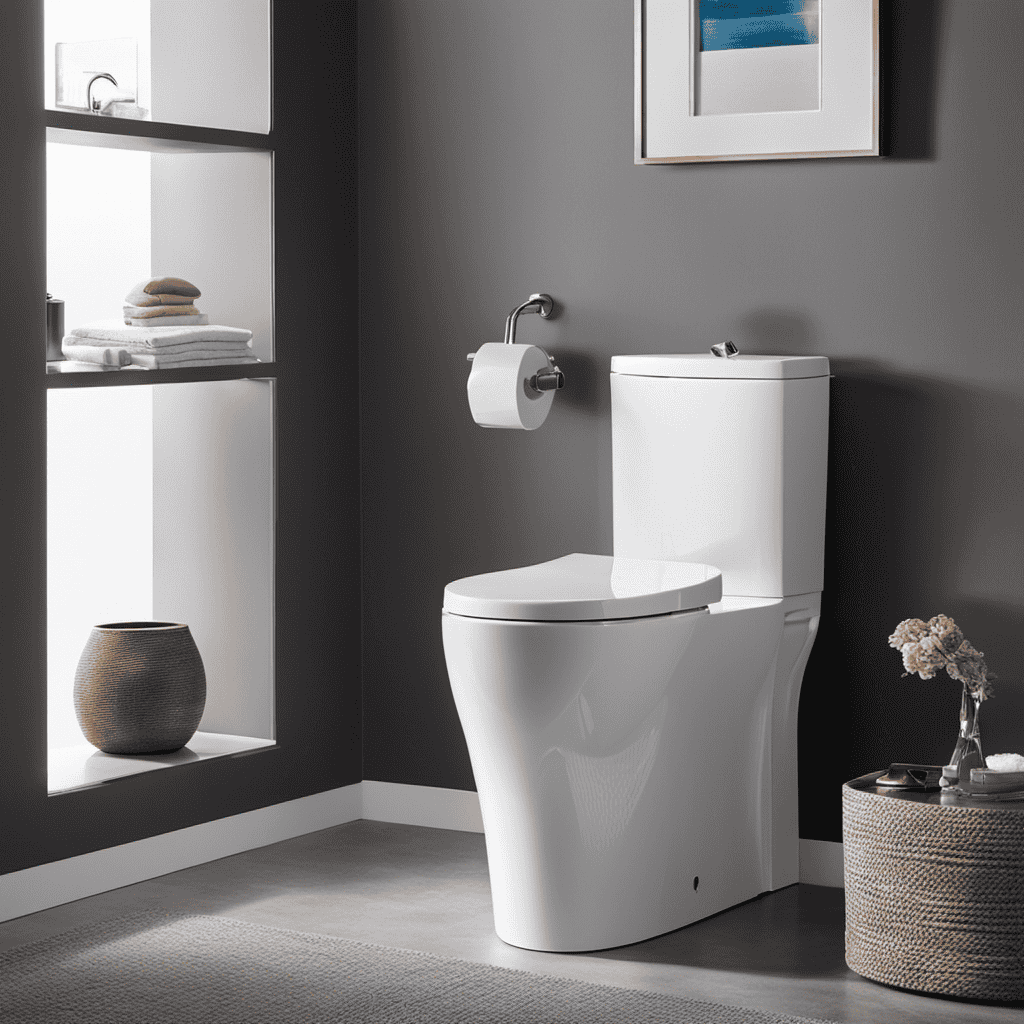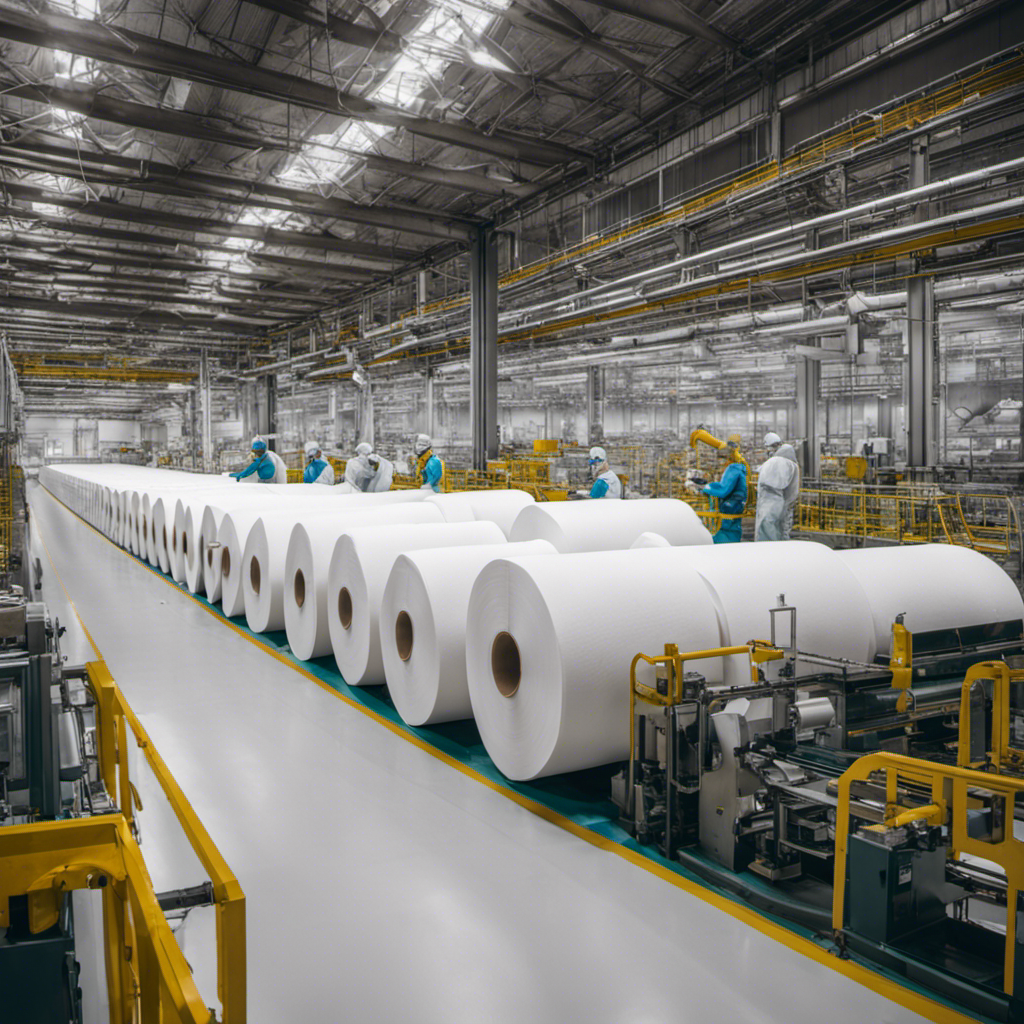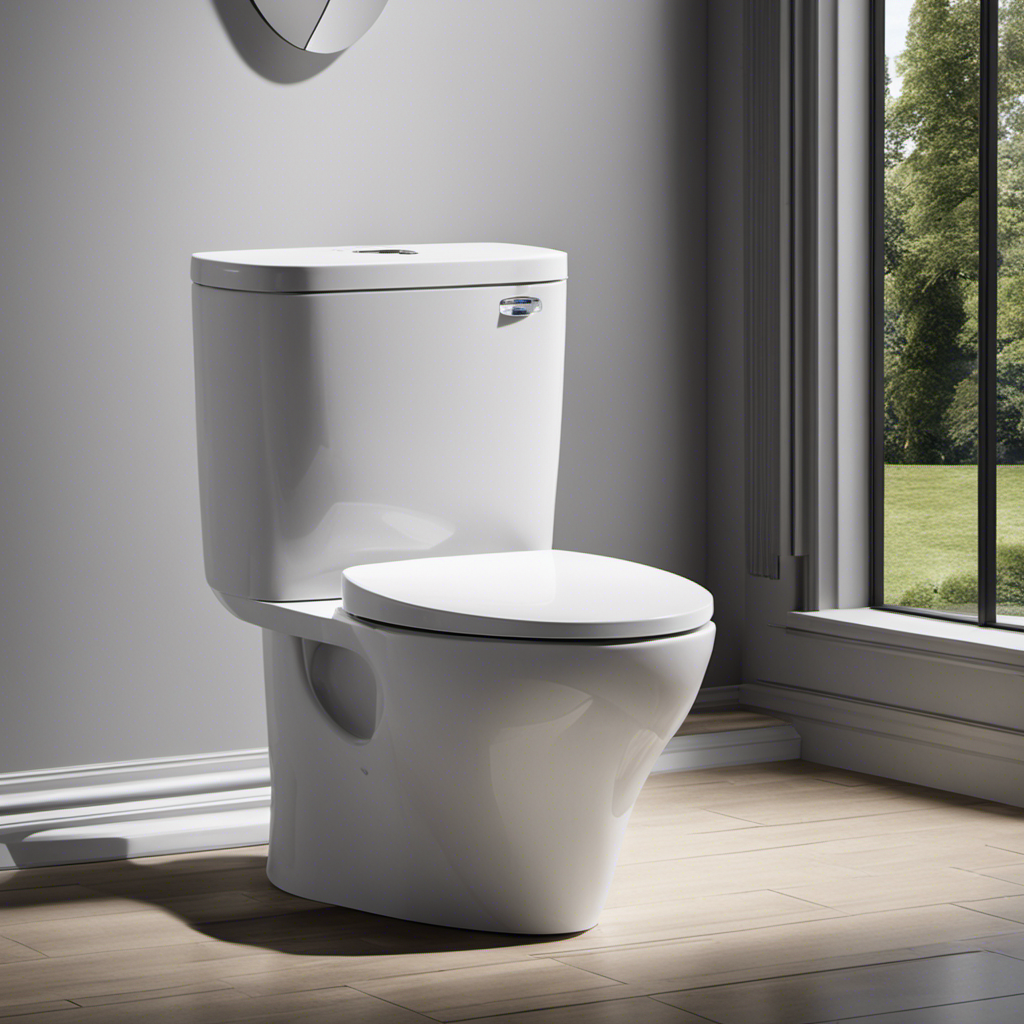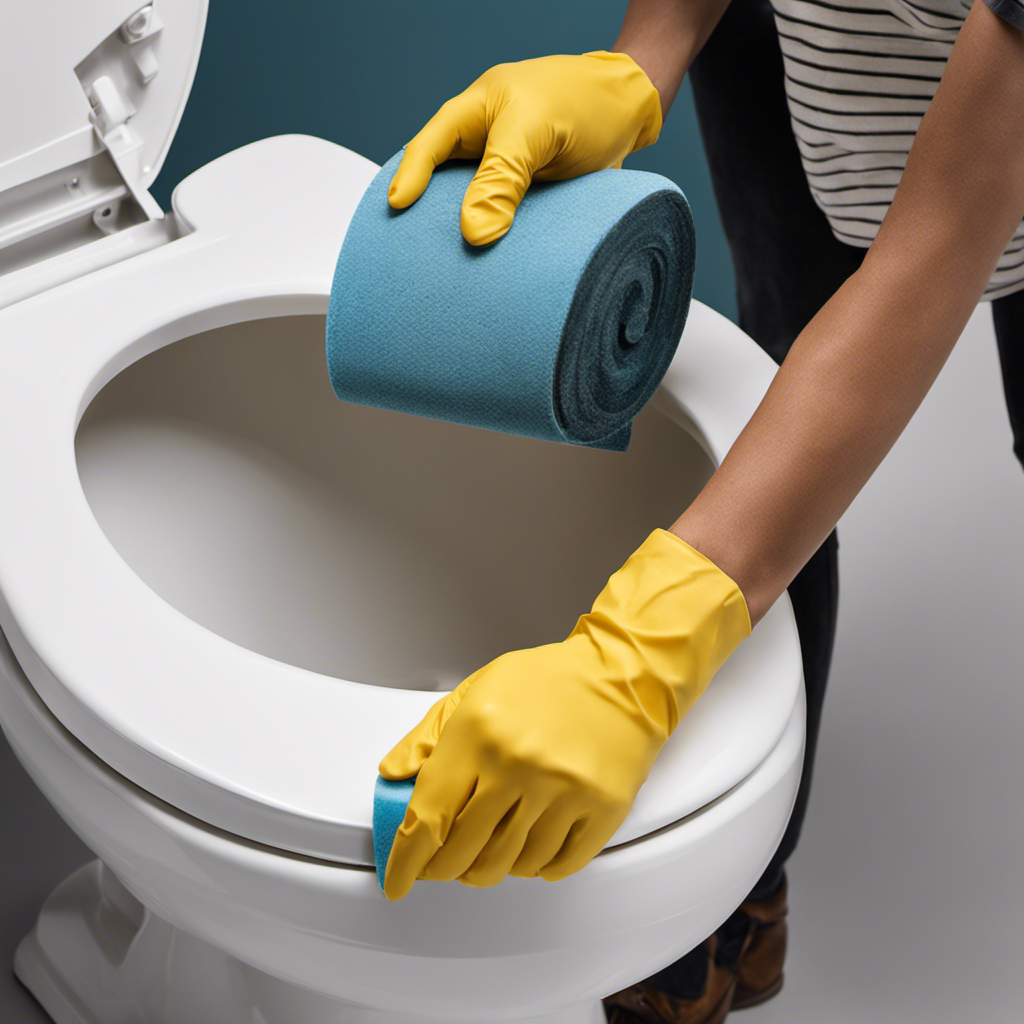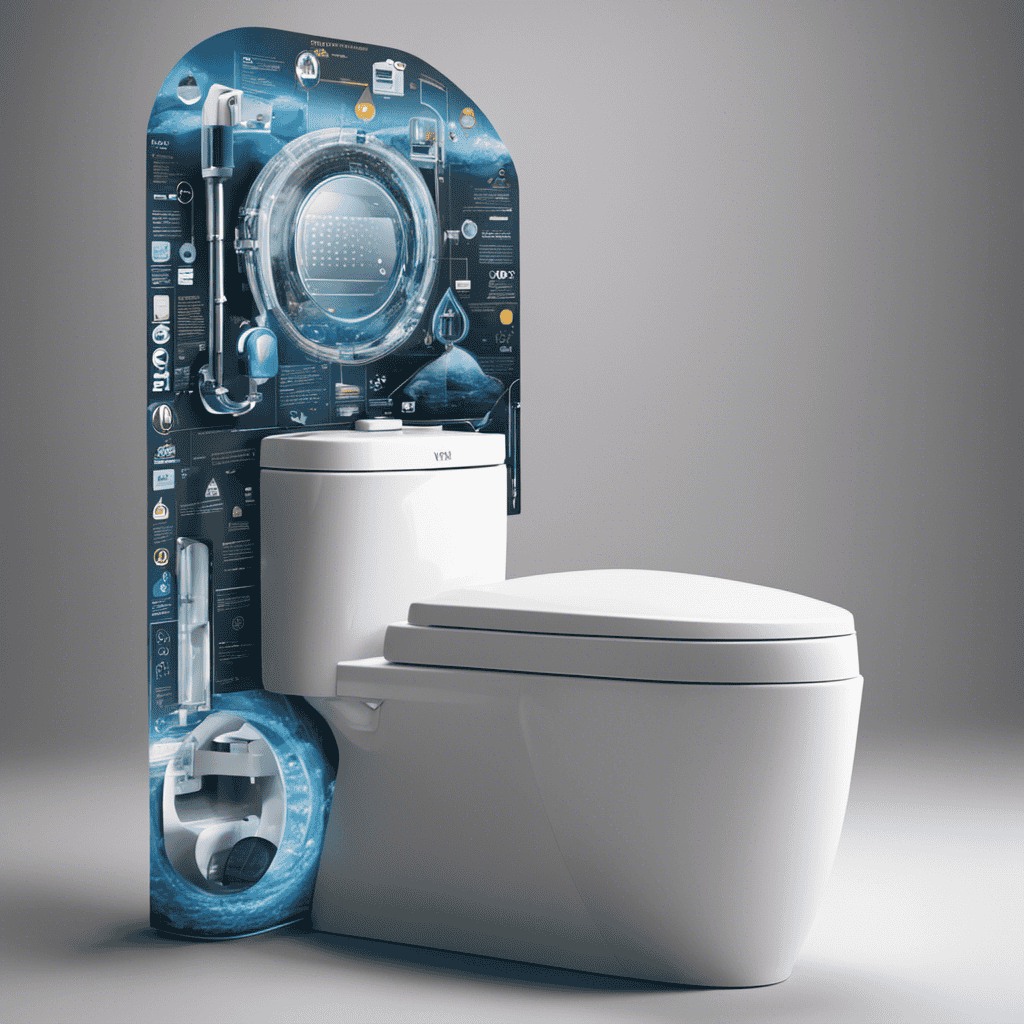As someone passionate about conserving water, I can confidently say that water-efficient toilets are like superheroes, swooping in to save the day. These innovative fixtures use advanced technology to drastically reduce water consumption, making them incredibly effective in saving this precious resource.
With dual flush mechanisms, pressure assistance technology, and low-flow designs, these toilets ensure every flush counts. In this article, I will delve into the technical details and data-driven benefits of water-efficient toilets, serving the needs of those concerned about water conservation.
Key Takeaways
- Dual flush mechanism allows users to choose between a full or partial flush, reducing water consumption by up to 50% compared to traditional toilets.
- Water-efficient toilets limit water volume to as low as 1.28 gallons per flush, significantly reducing water usage and conserving resources.
- Pressure assistance technology provides a more powerful flush, saving up to 20% more water compared to traditional toilets and reducing the need for multiple flushes.
- Efficient flushing mechanisms, such as dual-flush systems, pressure-assist technology, and sensors, promote water conservation and sustainability by maximizing water savings and ensuring proper waste removal.
The Role of Dual Flush Mechanism in Water-Efficient Toilets
I believe the dual flush mechanism plays a crucial role in water-efficient toilets by allowing users to choose between a full or partial flush, conserving water with each use.
This mechanism offers two options: a full flush for solid waste and a partial flush for liquid waste. On average, a full flush uses 1.6 gallons of water, while a partial flush uses only 0.8 gallons. This design reduces water consumption by up to 50% compared to traditional toilets that use a fixed amount of water per flush.
Dual flush toilets also contribute to sustainable bathroom fixtures by promoting water conservation. According to studies, these toilets can save up to 20,000 gallons of water per year in a typical household, making them an environmentally friendly choice for water-saving toilet designs.
How Reduced Water Volume Improves Water Efficiency in Toilets
Reducing the water volume in toilets improves water efficiency by decreasing the amount of water used per flush, ultimately saving significant amounts of water. The key to achieving this is through thoughtful toilet design that incorporates reduced water flow.
Traditional toilets typically use around 3.5 to 7 gallons of water per flush, whereas water-efficient toilets utilize advanced technology to limit the water volume to as low as 1.28 gallons per flush. This significant reduction in water usage not only helps in conserving water but also reduces the strain on water resources.
Water-efficient toilets achieve this by incorporating innovative flushing mechanisms, such as pressure-assist or gravity-assist systems, that effectively remove waste with minimal water usage. Additionally, design features like larger trapways and glazed surfaces also contribute to efficient flushing, ensuring effective waste removal while using less water.
Exploring the Benefits of Pressure Assistance Technology in Water-Efficient Toilets
After researching the topic, I discovered that pressure assistance technology in water-efficient toilets provides a more powerful flush, resulting in a cleaner bowl and less water usage.
The benefits and advantages of this technology are significant. By utilizing pressure assistance, these toilets are able to generate a higher level of force, effectively removing waste with less water. This not only ensures a cleaner bowl but also reduces the amount of water required per flush.
In fact, studies have shown that water-efficient toilets with pressure assistance technology can save up to 20% more water compared to traditional toilets. This not only contributes to water conservation efforts but also helps to lower water bills for consumers.
Additionally, the improved flushing power of these toilets reduces the need for multiple flushes, further conserving water and promoting a more hygienic bathroom experience.
Overall, pressure assistance technology in water-efficient toilets offers significant benefits and advantages, making them a smart and sustainable choice for both households and businesses.
The Functioning of Gravity-Fed Systems in Water Conservation
In order to fully understand the functioning of gravity-fed systems in water conservation, it is important to consider the role of both gravity and pressure in the movement and distribution of water. Gravity-fed systems rely on the force of gravity to move water from a higher elevation to a lower elevation. This movement creates pressure that allows water to flow through pipes and reach its intended destination. To illustrate the importance of gravity and pressure in water conservation, consider the following table:
| Gravity | Pressure |
|---|---|
| Allows water to flow downwards | Creates force for water movement |
| Relies on natural forces | Requires proper pipe sizing |
| Can be harnessed for sustainable water use | Ensures efficient water distribution |
| Supports conservation efforts | Minimizes water waste |
Understanding the functioning of gravity-fed systems lays the foundation for comprehending the importance of efficient flushing mechanisms in water-efficient toilets.
Understanding the Importance of Efficient Flushing Mechanisms in Water-Efficient Toilets
I appreciate the importance of efficient flushing mechanisms in water-efficient toilets, as they maximize water savings and ensure proper waste removal.
Understanding flushing mechanisms is crucial in designing toilets that effectively conserve water. One of the key water-saving features is the dual-flush system. This system allows users to choose between a full flush for solid waste and a reduced flush for liquid waste. By providing this option, water usage can be significantly reduced.
Another important feature is the use of pressure-assist technology. This mechanism uses pressurized air or water to forcefully remove waste, eliminating the need for multiple flushes.
Additionally, some toilets incorporate sensors that detect when the user has left and automatically initiate a flush, reducing the risk of wasted water.
These innovative flushing mechanisms, combined with water-saving features, play a significant role in conserving water and promoting sustainability.
The Impact of Dual Flush Toilets on Water Consumption
I’ve conducted a thorough analysis on the impact of dual flush toilets on water consumption, and the findings are impressive.
Dual flush toilets have proven to be highly effective in reducing water usage compared to traditional single flush toilets.
Studies have shown that by providing two flushing options, one for liquid waste and another for solid waste, dual flush toilets can help save up to 68% of water per flush, resulting in significant water conservation and cost savings.
Dual Flush Effectiveness
Although it may seem counterintuitive, dual flush toilets are actually more effective in saving water compared to traditional toilets. Here are the reasons why:
-
Adjustable Flush: Dual flush toilets have two flush options – a full flush for solid waste and a half flush for liquid waste. This allows users to choose the appropriate flush volume for their needs, minimizing water usage.
-
Water Efficiency: On average, dual flush toilets use 20% less water per flush compared to traditional toilets. This can result in significant water savings over time, reducing both water consumption and utility bills.
-
Smart Design: Dual flush toilets are designed with efficient water flow mechanisms and improved bowl shape. This ensures effective waste removal with less water, making them highly efficient in water usage.
-
Environmental Impact: By reducing water consumption, dual flush toilets contribute to water conservation efforts and help protect our natural resources. They’re an eco-friendly choice that aligns with sustainable living practices.
To maintain the optimal performance of dual flush toilets, regular maintenance is essential. Troubleshooting common issues such as leaking, incomplete flush, or clogging can be addressed by checking the fill valve, flapper, and water level adjustment. Proper care and maintenance will ensure the longevity and water-saving benefits of dual flush toilets.
Reduced Water Consumption
While dual flush toilets are effective in reducing water consumption, it’s important to also consider other water-saving measures in order to have a significant impact on overall water usage.
Implementing various water saving techniques and water conservation strategies can further enhance our efforts in preserving this valuable resource. For instance, installing low-flow showerheads can save up to 2.5 gallons of water per minute compared to traditional showerheads.
Additionally, fixing leaky faucets and pipes can prevent the wastage of thousands of gallons of water annually.
Outdoor water usage can also be minimized by using rain barrels to collect and reuse rainwater for activities such as watering plants and gardens.
Enhancing Water Efficiency With Low-Flow Toilet Designs
I recently learned that low-flow toilet designs are revolutionizing water efficiency by drastically reducing the amount of water used per flush. This breakthrough in toilet technology has numerous benefits and is an effective way to conserve water.
Here are the key reasons why low-flow toilets are so effective in saving water:
-
Efficient flushing mechanism: Low-flow toilets use advanced flushing mechanisms that require less water to effectively remove waste. This ensures that every flush is efficient and doesn’t waste unnecessary water.
-
Dual-flush options: Many low-flow toilets offer dual-flush options, allowing users to choose between a lower water volume for liquid waste and a higher volume for solid waste. This flexibility reduces water consumption by tailoring the flush to the specific type of waste.
-
Water-saving technologies: Low-flow toilets often incorporate innovative technologies such as pressure-assisted flushing or gravity-assisted flushing, which optimize the use of water and minimize wastage.
-
Water conservation regulations: Low-flow toilets are designed to meet water conservation regulations and standards set by organizations like the Environmental Protection Agency. By adhering to these guidelines, low-flow toilets ensure that water is used efficiently and responsibly.
With their numerous benefits and water-saving designs, low-flow toilets are an excellent choice for those who desire to serve others by conserving water.
The Advantages of Pressure-Assisted Toilets in Water Conservation
Pressure-assisted toilets offer several advantages in water conservation.
Firstly, their strong flushing power ensures effective waste removal with each flush, reducing the need for multiple flushes and saving water.
Secondly, these toilets are designed to use less water per flush compared to traditional gravity-fed toilets, further contributing to water conservation.
Lastly, the pressure-assisted mechanism helps prevent clogs, reducing the frequency of maintenance and water wastage caused by clogged toilets.
Strong Flushing Power
The strong flushing power of pressure-assisted toilets ensures efficient water conservation. Here are four reasons why strong flushing power is crucial for water saving technology:
-
Increased efficiency: The powerful flushes of pressure-assisted toilets effectively remove waste in a single flush, reducing the need for multiple flushes and saving water.
-
Prevents clogs: The strong flushing power prevents clogs by pushing waste through the trapway with force, minimizing the need for excessive water usage to clear blockages.
-
Complete cleaning: The forceful flushes of pressure-assisted toilets ensure thorough cleaning of the bowl, reducing the need for additional water for cleaning purposes.
-
Reduced maintenance: Strong flushing power helps prevent buildup of waste and debris, minimizing the need for frequent maintenance and repairs, which in turn saves water.
Reduced Water Consumption
Using pressure-assisted toilets can lead to significant water savings, and the reduced consumption is a major advantage in water conservation efforts. These toilets utilize a combination of air and water pressure to enhance flushing power while using less water. Compared to conventional gravity flush toilets, pressure-assisted toilets can save up to 38% more water per flush, making them an effective water-saving strategy.
To illustrate the impact of reduced water consumption, let’s consider the following table:
| Toilet Type | Water Consumption per Flush (gallons) |
|---|---|
| Gravity Flush | 1.6 |
| Pressure-Assisted | 1.0 |
| Water Savings | 0.6 |
As shown in the table, pressure-assisted toilets consume 0.6 gallons less water per flush compared to gravity flush toilets. This translates to significant water conservation, especially in high-traffic areas such as public restrooms or commercial buildings.
Transitioning to the next section about how pressure-assisted toilets prevent clogs effectively, let’s explore their unique flushing mechanism.
Prevents Clogs Effectively
I frequently notice that pressure-assisted toilets effectively prevent clogs, ensuring a hassle-free experience. Here are four reasons why they’re so efficient in preventing clogs:
-
Powerful Flush: Pressure-assisted toilets use compressed air or water to create a forceful flush, which helps to eliminate waste effectively. This powerful flush ensures that most clogs are prevented before they even happen.
-
Reduced Water Usage: Despite their powerful flush, pressure-assisted toilets are designed to use less water compared to traditional toilets. This water-efficient feature not only saves water but also prevents clogs by effectively clearing the waste with less water.
-
Enhanced Bowl Design: Pressure-assisted toilets often feature an enhanced bowl design that promotes better waste removal. The design incorporates a larger trapway and a sleeker surface, allowing waste to flow smoothly without getting stuck.
-
Improved Plumbing Performance: By preventing clogs, pressure-assisted toilets help maintain the overall performance of your plumbing system. They reduce the chances of backups and blockages, ultimately saving you time, money, and hassle.
With their efficient flush and innovative design, pressure-assisted toilets are an excellent choice for those seeking a clog-free experience while conserving water.
Other Innovative Technologies for Water Conservation in Toilets
While there are many effective water-saving technologies for toilets, one innovative option to consider is a dual-flush system. This system allows users to select between a lower volume flush for liquid waste and a higher volume flush for solid waste. By providing this choice, water consumption can be significantly reduced.
In addition to dual-flush systems, there are other technologies that contribute to water conservation in toilets. One such technology is low flow technology, which restricts the flow of water during a flush. This reduces the amount of water used without compromising the flushing performance. Another innovative option is smart toilet innovation, which incorporates advanced sensors and controls to optimize water usage based on user behavior and needs.
To give you a better understanding, here is a table showcasing the water savings potential of different water-efficient toilet technologies:
| Technology | Average Water Savings (per flush) |
|---|---|
| Dual-Flush System | 20-30% |
| Low Flow Technology | 30-40% |
| Smart Toilet Innovation | 40-50% |
As you can see, these technologies offer substantial water savings, making them essential for sustainable water management. By implementing these innovations, we can contribute to the conservation of water resources while still providing efficient and effective toilet systems.
Frequently Asked Questions
What Is the Average Water Consumption of a Traditional Toilet Compared to a Water-Efficient Toilet?
The average water consumption of a traditional toilet is significantly higher compared to a water-efficient toilet. Traditional toilets can use around 3.5 to 7 gallons of water per flush, whereas water-efficient toilets use only about 1.28 gallons per flush.
This substantial difference in water usage makes water-efficient toilets highly effective in saving water. By reducing the amount of water used per flush, these toilets help conserve water resources and contribute to overall water sustainability.
Are Water-Efficient Toilets More Expensive Than Traditional Toilets?
Water-efficient toilets may seem more expensive upfront, but when you consider the long-term savings, they’re actually a cost-effective choice. Studies show that water-efficient toilets can save up to 50% more water compared to traditional toilets.
This means that over time, the reduced water usage can significantly lower your water bills. Additionally, water-efficient toilets contribute to a more sustainable future by conserving valuable water resources.
Can Water-Efficient Toilets Be Installed in All Types of Buildings?
Water-efficient toilets can be installed in all types of buildings, including historical ones. Retrofitting water efficient toilets in historical buildings is an effective way to save water while preserving the building’s integrity. These toilets use advanced flushing mechanisms and designs that minimize water usage without compromising performance.
With their lower water consumption, water-efficient toilets help reduce water waste and contribute to sustainable water management. Installing them in all types of buildings promotes water conservation and supports the goal of serving others by preserving our precious water resources.
Can Water-Efficient Toilets Handle Solid Waste as Effectively as Traditional Toilets?
When it comes to handling solid waste, water-efficient toilets perform just as effectively as traditional toilets. These toilets use less water for flushing, but still have the necessary power to remove solid waste. They’re designed with innovative technology that optimizes the force and flow of water, ensuring efficient waste removal.
This not only saves water, but also reduces strain on sewage systems. Water-efficient toilets are a practical and sustainable solution for conserving water without compromising on performance.
Are There Any Government Regulations or Incentives for Using Water-Efficient Toilets?
Government regulations and financial incentives play a crucial role in promoting the use of water-efficient toilets.
By implementing regulations that mandate the installation of these toilets in new buildings or during renovations, governments encourage their adoption.
Additionally, financial incentives such as rebates or tax credits make it more financially attractive for individuals and businesses to invest in water-efficient toilets.
These measures help to reduce water consumption and promote sustainable practices in water management.
Conclusion
In conclusion, water-efficient toilets play a crucial role in conserving water resources. By incorporating dual flush mechanisms, reduced water volume, pressure assistance technology, and efficient flushing mechanisms, these toilets significantly reduce water consumption.
One interesting statistic to highlight is that water-efficient toilets can save up to 20,000 gallons of water per year for an average household, contributing to a more sustainable and environmentally friendly future.
